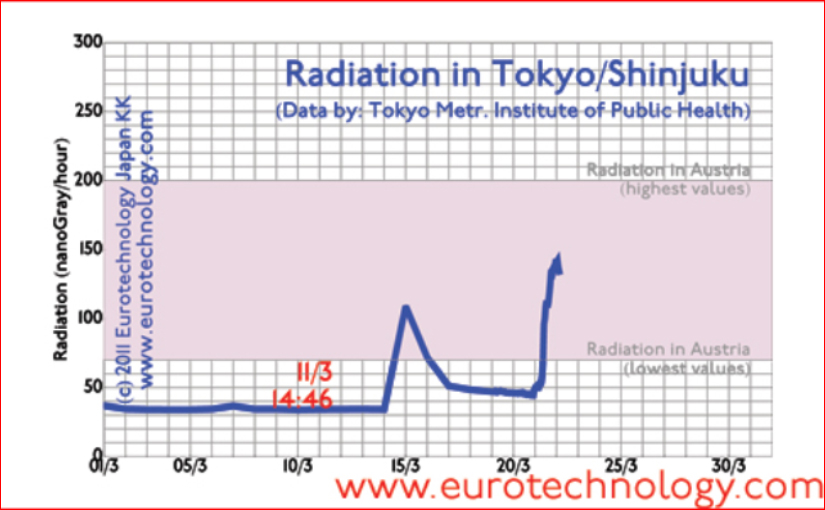Radiation in Tokyo due to the Fukushima nuclear disaster
Our second update of the radiation and disaster situation in Tokyo, as of 22 March 2011
Suffering caused by the Friday March 11, 14:46 earthquake in Japan continues, but we see hope and reconstruction. Tomorrow the new high-speed train line north of the disaster zone is planned to run again between Shin-Aomori and Morioka. Radiation in Tokyo is evolving due to the Fukushima disaster and explosions and melt-down of nuclear reactors.
Japan’s society has developed over 100s of years coping with similar disasters, and it is already obvious that Japan will overcome this disaster strengthened. In recent years, Japan overcame the Kobe-Earthquake and the Niigata-Earthquake, and Japan will also overcome this earthquake soon. We observe many discussions to learn from this disaster and to strengthen Japan.
In this newsletter we focus on analysis of radiation risks (see below) in Tokyo, and on US and EU response.
Radiation in Tokyo: situation in Tokyo

We see Japanese companies and Japanese workers – including our company Eurotechnology-Japan here in Tokyo – working almost normally throughout the period of after-quakes. A notable exception is the account settlement IT system of Mizuho-Bank which apparently has broken down.
Electricity savings by the population were beyond expectations, so that planned electricity cuts have been largely avoided – most electricity cuts were announced but not implemented – the electricity keeps flowing in most areas, especially in the central areas.
While many long-term foreign residents remained in Tokyo, a large fraction of temporary foreigners left either to Osaka, or left Japan altogether.
The departure of some foreigners (and some Japanese) has not been un-noticed.
One of my friends, Japanese surgeon (medical doctor) at Tokyo University’s hospital, who had stayed at the bedside of patients throughout the quake, broke down in tears telling me about a colleague leaving Tokyo during the after-quakes.
US actions – Operation Tomodachi
“Operation Tomodachi”: The US Pacific Command has built up a massive help and relief effort “Operation Tomodachi”, which involves US Air Force, US Marine Corps, US Army (458 personell + 1000 contractors), US Navy (12,750 personell participating in Operation Tomodachi). A summary of US Pacific Command help to Japan including “Operation Tomodachi” can be found here. In particular, US experts and loaned equipment are helping with the Fukushima nuclear power stations, US is working to repair Sendai Airport and other damaged infrastructure so that supplies can be forwarded, and US military is delivering supplies including food, blankets, fuel and water into the disaster area.
According to announcements by the US Ambassador Roos, the US Embassy in Tokyo has increased staffing by about 30%, and 96 US Government employees and experts have arrived from outside Japan to help.
EU actions
EU response: summarized here on the EU website .
Many EU country Embassies have reduced staff or shut down in Tokyo. (This is in stark contrast to the actions of the US Embassy in Japan, which actually increased staff numbers).
Situation at the Fukushima Reactor
Through heroic work of the fire fighters at the reactors the situation seems to stabilize and improve in the right direction. The International Atomic Energy Agency website summarizes the the situation officially here dated March 20, 2011. It appears that since March 20 the situation has improved further.
We here at Eurotechnology-Japan are continously working here in Tokyo for you – and our customers. We actually closed new business contracts a few days after the March 11 earthquake.

Comments and discussions